Kitchen retailer Steamer Trading has opened an architecturally bold store that is sure to impress. John Ryan gets a tour in historic Guildford.
Guildford’s a nice place. In fact, there’s nothing to object to about any of it – a castle, a river, a historic (now private) grammar school, and one of the country’s most beautiful high streets. And as if this were not enough, it is also deeply affluent – the kind of place where people do actually stop and pay for a copy of the Big Issue, because they can afford to.
The high street itself features historic, almost entirely listed, Georgian buildings of the kind that anyone who agrees with the long-time heir to the throne would find pleasing. And as such, retail properties don’t become available very often and when they do, they tend to be solidly hedged around by planning restrictions.
Not, therefore, the sort of city that you’d expect to find a highly contemporary glass and steel shop. And until very recently, this was the case.
Walk up to the top of the hill that is the high street and the thing that used to dominate the view was a metal statue of George Abbot, a former Archbishop of Canterbury. He’s still there, but now a branch of kitchenwares retailer Steamer Trading vies for your attention.
Well steeled for business
The reason that it almost takes centre stage is because of the form of its frontage. This is a predominantly steel and glass cube that juts out from the line of buildings and is wildly at odds with its neighbour, “Constitution Hall”, which has been, at various points, a cinema, bookshop and, latterly, a branch of failed furniture retailer New Heights. It was built in 1885.
The four-floor, 7,500 sq ft Steamer Trading store was previously a very unremarkable HSBC branch that Ben Phillips, the retailer’s managing director, says was acquired at a very “advantageous” price during the turmoil surrounding the bank late last year.
What is remarkable about what was there before is how it got through the planning process, as a tall, slab-sided structure with no features of particular architectural merit is hardly the stuff of which county town preservation societies’ dreams are made. This may go some way towards explaining why the planners have been “so supportive” of Phillips’ plans for remodelling the site – almost anything would have been better than what was there before.
That said, what Guildford has ended up with is a store that Phillips claims has the “second largest commercial pane of glass in the UK” – the largest is in Blenheim Palace, apparently –
covering the front of its upper level. This outsize window is 5.3 metres
high and glazing the shopfront cost £125,000 – not an outrageous sum when the size and height of the area is considered. It has also given the store a street shout way beyond that of its immediate neighbours.
All of the glass is framed by a thick, black steel structure that strikes an urban, metropolitan note not really found elsewhere in Guildford. The design of the whole store is the work of London-based Mark Guard Architects, which also created some of the look and feel of Steamer Trading’s brighton“>Brighton store. The fact that this is a modern building is no surprise. Mark Guard works predominantly on über-cool residential projects of the kind that make you think ‘this must have been designed by an architect’ variety.
Step inside the shop and the vista is equally uncompromising. At the heart of the store is a large metal staircase, with, in effect, corridors to the back of the ground floor on either side of it.
But long before you get to the back of the shop you will probably have noticed the decision has been made to fill the space immediately inside the window with fake Christmas trees, rather than stock. Phillips says this was very deliberate: “If you’re going to do Christmas, then do it,” he says.
Get past this and the next thing that will catch the eye is the knife cabinet. This internally lit structure is built into the right-hand perimeter wall, next to the staircase, and is as much a showpiece for this store as it is in the Marlow store (Retail Week, October 15, 2008), which opened last year.
Phillips says this is an important element of getting men into the shop, as “men like tools”. The difference between this branch and the Marlow store is that there also a free-standing piece of equipment, constructed from glass and marine plywood, that is used to house the most expensive cutting and stabbing implements. For those with £300 to lavish on a single knife, this is the place to do so – there is even a pair of matched sabres, for those wishing to open champagne in the traditional show-offy way.
Off the wall
On the other side of the staircase there is another Steamer Trading show piece – a wall of food mixers and toasters, with machines from big-name brands such as Dualit and Magimix, none of them cheap, filling perfectly engineered open-fronted wooden boxes along the perimeter.
It is a measure of how carefully everything has been thought through that the edges of these boxes line up exactly with the metal joists that support the next floor up and yet, all of the boxes are the same size. This store is about precision engineering.
Beyond the staircase it’s coffee-making equipment – from around £100 up to £1,700, if you’re rich – a cash desk constructed from the same marine ply and then, at the back of the floor, cookware; Le Creuset sets and suchlike. As in other Steamer Trading stores, the key to both layout and effect is the power of visual merchandising and colour.
Head for the staircase, with its polished concrete treads, and the basement is what some retailers would term the “essentials floor”. But it is essentials on steroids and if potato peelers are your thing, for instance, there are 62 different options, according to Phillips. All of these are made to sing by artful colour blocking, providing a contrast to the understated, large, dark grey tiles that have been used to cover the floor.
The first floor is about considered purchases and gifts, says Phillips. The great majority of the stock is branded, with everything from the brightly coloured Italian Guzzini tableware, made of heavy duty plastic, to objects formed of crystal in the shape of birds. Phillips says he expects this to be the floor on which people linger for up to 30 minutes, as little of the offer is about impulse buying. The fact that it’s the stock that you notice, even allowing for the glass floor, in parts, and the good-looking architecture, is a tribute to how this store works as a showcase, but does not overwhelm the merchandise.
It’s also worth noting the street-facing part of this shop, which affords visitors views back down the hill along Guildford High Street. Three rows of heavy duty steel shelving have been wedged, cheek by jowl, with the external glass line in this area, and used as a home for 70 steel cooking pots: tagines. These are heavy-duty pieces of cookware and the robust nature of the building’s steel frame is put to the test.
Above this, there is another floor, that will be home to a 1,500 sq ft cafe, but this is still under construction and will not be ready until the new year. There is another Steamer Trading outlet in Guildford – a little further along the street – but this will close after Christmas.
Overall, Guildford’s the winner, with a state-of-the-art kitchen store where architecture, visual merchandising and product combine to create an entirely beguiling space.
Steamer Trading, Guildford
Location Guildford High Street
Size 7,500 sq ft, including a 1,500 sq ft cafe that is still under construction
Total conversion and build cost “Around £2m”
Architecture and design Mark Guard Architects
Shopfitting RS Sets





















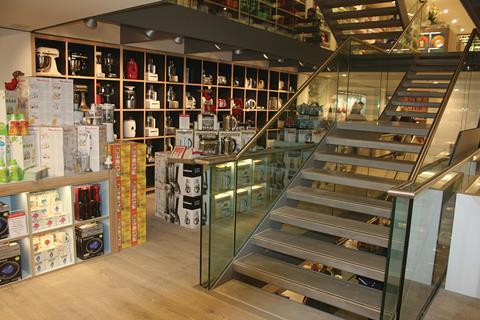
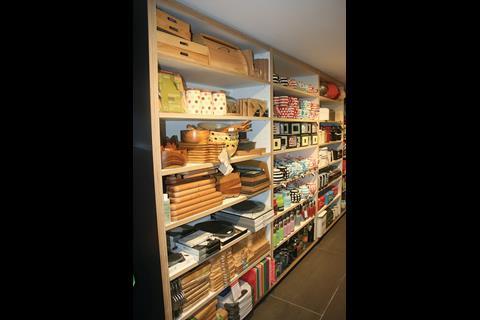
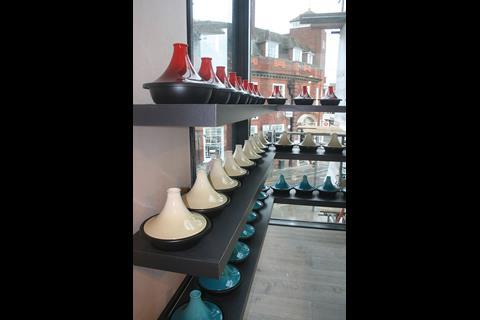
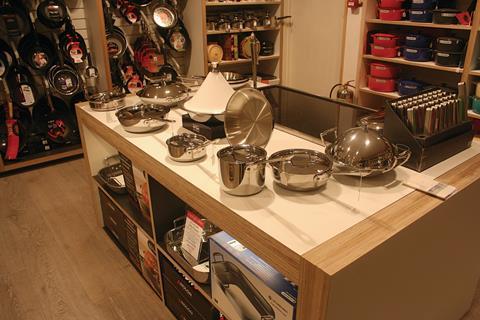
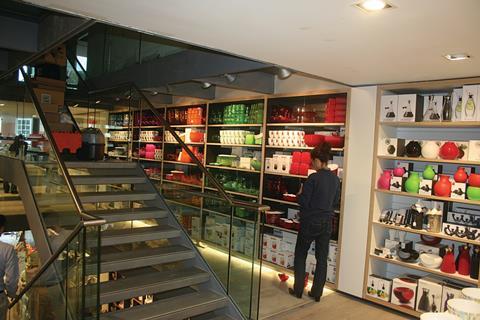


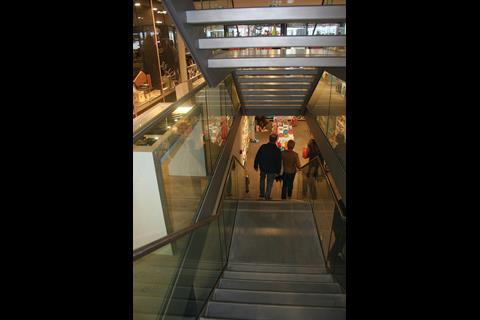

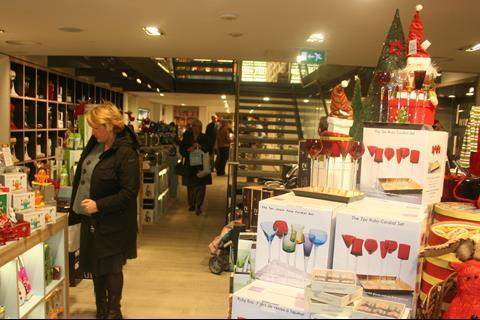








No comments yet